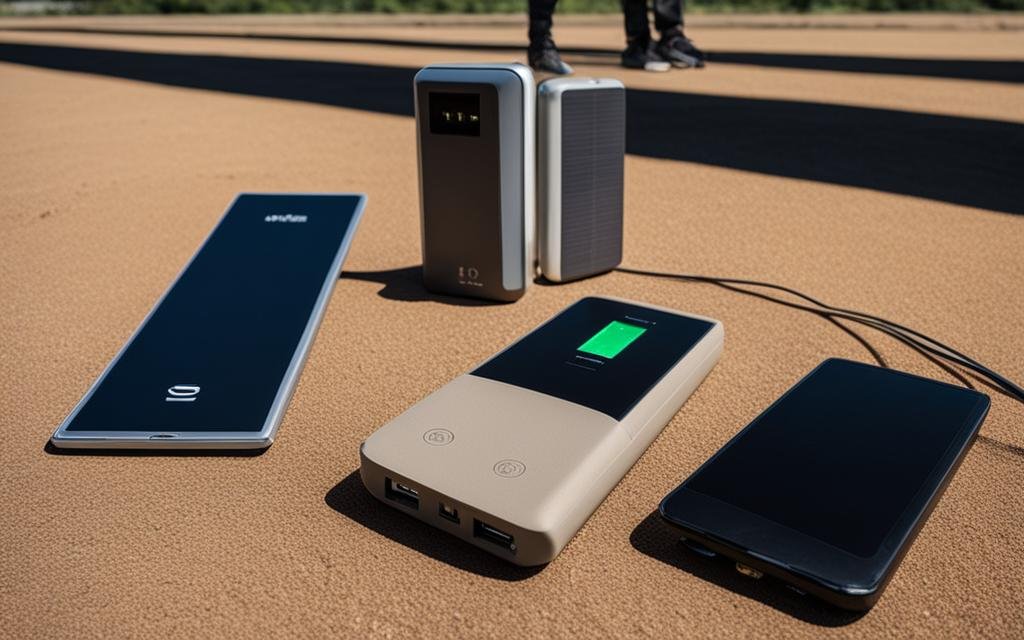When it comes to charging your devices on the go, two popular options are portable power banks and solar power banks. Portable power banks are a compact battery pack that can charge your devices through a USB port, while solar power banks use solar panels to harness the sun’s energy and charge your devices.
Both options have their own pros and cons, and choosing between them can be a tough decision. In this article, we will explore and compare portable power banks and solar power banks in detail, helping you make an informed decision on which option is best suited for your needs.
At times, you may find yourself without access to electrical outlets, making a portable power bank an ideal solution for charging your devices while on the move. Portable power banks come in various sizes, ranging from small and pocket-sized to larger, high-capacity ones suitable for charging multiple devices. They are a great option for travel, providing the convenience of charging your devices without having to worry about finding an electrical outlet.
Solar power banks, on the other hand, are particularly useful for outdoor activities such as hiking, camping, or any other activity where you may not have access to an electrical grid. Harnessing the power of the sun to charge your devices, solar power banks are environmentally friendly and sustainable options for charging your devices while spending time in nature.
Comparing portable power banks and solar power banks can be quite challenging, as each option has its own unique strengths and weaknesses. While portable power banks offer convenience and versatility, solar power banks offer an eco-friendly and reliable charging option. Ultimately, choosing between portable power banks and solar power banks will depend on your individual requirements and circumstances.
Throughout the rest of this article, we will explore the benefits and advantages of portable power banks and solar power banks in more detail. We will also provide a list of factors to consider when choosing between these two options, helping you make an informed decision.
Understanding Portable Power Banks
If you’re always on the go and need to keep your devices charged, portable power banks are a great solution to stay connected. These handy little devices are compact and easy to carry, making them ideal for travel or outdoor activities.
Portable power banks work by storing energy in internal batteries, which can then be used to charge your devices through a USB port. The capacity of a power bank is typically measured in milliampere-hours (mAh) and determines how much charging power the device has.
There are many benefits to using a portable power bank, including the ability to charge your device on-the-go. Whether you’re traveling on a long flight, hiking in the mountains, or simply commuting to work, a portable power bank can keep your phone, tablet, or other devices charged and ready to use.
When looking for the best portable power banks, consider the capacity, size, and weight of the device, as well as the number of charging ports. Some power banks also come with additional features, such as built-in flashlights or solar panels for recharging the battery.
Choosing the Right Portable Power Bank for Travel
When selecting a portable power bank for travel, there are a few factors to keep in mind. First, consider the capacity of the power bank. A higher mAh rating means the device can charge your device more times before needing to be recharged itself.
The size and weight of the power bank are also important considerations, especially if you’re planning to carry it around with you while traveling. Look for a model that is compact and lightweight, and that can easily fit into your luggage or backpack.
Finally, check to see if the power bank has multiple USB charging ports. This can be useful if you need to charge more than one device at a time, such as a phone and a tablet.
- Choose a power bank with a high capacity (at least 10,000 mAh).
- Look for a compact and lightweight design.
- Check for multiple USB charging ports.
With these features in mind, you can find the best portable power bank for your travel needs and stay connected wherever you go.
Exploring Solar Power Banks
If you’re someone who spends a lot of time outdoors or is always on the go, a solar power bank could be the solution to your charging needs. Solar power banks work by harnessing the power of the sun to charge your devices, making them a sustainable and environmentally friendly option.
One of the advantages of solar power banks is that they are ideal for outdoor activities such as hiking, camping, and backpacking. They are lightweight and portable, making them easy to carry in a backpack or pocket. Additionally, solar power banks are designed to withstand extreme weather conditions, so you don’t have to worry about them malfunctioning in the rain or snow.
Best Solar Power Banks
If you’re considering purchasing a solar power bank, there are several excellent options on the market. One of the best is the Anker PowerCore Solar 10000, which has a high-capacity 10,000mAh battery and two USB ports for charging multiple devices at once. Another great option is the RAVPower Solar Charger 25000mAh, which has a large battery capacity and can charge up to three devices simultaneously.
Pro Tip: Keep an eye out for RAVPower discount codes, which can help you secure significant savings on your order, making your purchase more budget-friendly.
Students and military personnel? You can now enjoy special discounts on tech gear that will make upgrading your electronics even more affordable. Thanks to our exclusive Anker offers, you can get your hands on the latest gadgets and accessories without breaking the bank.
Other notable solar power banks include the Nekteck Solar Charger 10000mAh, which is compact and lightweight, making it perfect for travel, and the Hiluckey Solar Charger 25000mAh, which features a durable and waterproof design for added reliability.
Overall, solar power banks are a sustainable and convenient option for powering your devices, especially during outdoor activities. By harnessing the power of the sun, you can keep your devices charged without relying on traditional power sources.

Comparing Portable Power Banks and Solar Power Banks
When it comes to charging your devices on the go, portable power banks and solar power banks are two of the most popular options. Both offer unique advantages and disadvantages, and choosing between the two can be a difficult decision. In this section, we will compare portable power banks and solar power banks in detail, highlighting the benefits of portable power banks and the advantages of solar power banks. This comparison will help you make an informed decision on which option is most suitable for your needs.
Benefits of Portable Power Banks
Portable power banks are battery-powered devices that you can use to recharge your devices while on the go. They provide a convenient charging solution for when you don’t have access to a power outlet. Some of the key benefits of portable power banks include:
- Portability: Portable power banks are small and lightweight, making them easy to carry in your bag or pocket. They are perfect for travel or when you’re on the move.
- Charging Capacity: Portable power banks come in different sizes and capacities, ranging from small 3,000mAh power banks to larger 20,000mAh power banks. This gives you the flexibility to choose a power bank that can meet your device charging needs.
- Convenience: Portable power banks are easy to use. Simply plug your device into the power bank using a charging cable and press the power button to start charging.
- Affordability: Portable power banks are generally less expensive than solar power banks, making them a more budget-friendly option.
Advantages of Solar Power Banks
Solar power banks are battery-powered devices that use solar panels to charge their batteries. They provide a sustainable charging solution that harnesses renewable energy. Some of the key advantages of solar power banks include:
- Sustainability: Solar power banks use renewable energy to charge their batteries, making them an environmentally friendly option. They are perfect for outdoor activities such as camping or hiking, where access to electricity is limited.
- Independence: Solar power banks can be charged using sunlight, eliminating the need for a power outlet. This makes them ideal for use in off-grid locations.
- Durability: Solar power banks are built to withstand harsh outdoor environments. They are water-resistant and shockproof, making them a reliable option for outdoor activities.
- Longevity: Solar power banks have a longer lifespan than portable power banks, making them a more cost-effective option in the long run.
*Planning your Solar Power Bank purchase? Grab a Renogy discount code for extra savings.
While both portable power banks and solar power banks have unique advantages, choosing between the two ultimately comes down to your individual needs and preferences. If you require a charging solution for travel or everyday use, a portable power bank may be the best option for you. However, if you enjoy outdoor activities and want a more sustainable and independent charging solution, a solar power bank may be the way to go. In the next section, we will discuss important factors to consider when deciding between portable power banks and solar power banks.
Factors to Consider When Choosing Between Portable Power Banks and Solar Power Banks
Choosing between portable power banks and solar power banks can be a daunting task, but there are a few factors that can help you make the right decision. Here are some key aspects to consider:
Charging capacity
One of the most important factors to consider is the charging capacity. Portable power banks usually have a higher capacity than solar power banks, meaning they can charge your devices multiple times before needing to be recharged themselves. Solar power banks, on the other hand, rely on sunlight to provide power, which can take longer and may not be as consistent.
Portability
If portability is a major concern, then a portable power bank may be the better option. They are usually smaller and more compact than solar power banks, making them easier to carry around with you on the go.
Reliability
Both portable and solar power banks have their own set of reliability concerns. Portable power banks can sometimes fail to charge devices due to various reasons like low battery capacity, loose connections, or poor quality. Solar power banks can only charge effectively in direct sunlight, meaning that if you live in a place with limited sunshine, they may not be the most reliable option for you.
Environmental impact
If you are environmentally conscious, then a solar power bank might be the perfect fit for you. Solar power banks rely on renewable energy, which is a sustainable and eco-friendly source of power. Portable power banks, on the other hand, rely on electricity, which may come from non-renewable sources such as coal or natural gas.
Considering these factors will help you make an informed decision when it comes to choosing between portable power banks and solar power banks. Keep in mind your individual needs and preferences to select the option that best aligns with them.

Making the Right Choice: Portable Power Banks or Solar Power Banks?
After exploring the pros and cons of portable power banks and solar power banks, it’s time to choose the right option for your needs. Keep in mind that both options have their own advantages and disadvantages, depending on your usage and preferences.
If you prioritize portability and convenience, a portable power bank is the way to go. These devices are compact and easy to carry around, making them ideal for travel or everyday use. They also tend to have higher charging capacities compared to solar power banks, which means they can charge your devices multiple times before needing to be recharged themselves.
On the other hand, if you prefer a more environmentally friendly option or plan to use your charging device primarily for outdoor activities, then a solar power bank might be the better choice. These devices rely on solar energy to charge your devices, reducing your dependency on electricity. However, they generally have lower charging capacities and may take longer to charge your devices, which may not be ideal for everyone.
Ultimately, the decision comes down to your personal preferences and usage. Consider factors such as charging capacity, portability, reliability, and environmental impact when making your choice. It may also be helpful to read reviews and compare different models before making a purchase.
Whichever option you choose, both portable power banks and solar power banks offer convenient solutions for charging your devices on-the-go. With the wide variety of options available in the market, you’re sure to find one that fits your needs and budget. Happy charging!
Conclusion
After exploring both portable power banks and solar power banks, you now have a better understanding of their respective pros and cons.
If you are looking for a charging option that is reliable, portable, and easily accessible, portable power banks are a great choice. They offer a wide range of charging capacities and are suitable for travel purposes.
On the other hand, if you enjoy outdoor activities and want a charging solution that is eco-friendly and sustainable, solar power banks are a great option. They harness solar energy and do not require electricity to operate, making them an environmentally conscious choice.
Ultimately, the choice between portable power banks and solar power banks comes down to your individual needs and preferences. Consider factors such as charging capacity, portability, reliability, and environmental impact before making your decision.
With the information provided in this article, you can confidently choose between portable power banks and solar power banks, knowing that you have made the right choice for your charging needs.
FAQ
What is a portable power bank?
A portable power bank is a portable device that stores electrical energy and can be used to charge your electronic devices on the go. It is essentially a portable battery pack that you can carry with you to provide additional power when your devices’ built-in batteries are running low.
How does a portable power bank work?
Portable power banks have built-in lithium-ion batteries that store electrical energy. When you connect your electronic device to the power bank using a USB cable, the stored energy is transferred to your device, charging it. The power bank itself can be charged by connecting it to a power source, such as a wall outlet or a computer, using a charging cable.
What are the benefits of using a portable power bank?
Portable power banks offer several benefits. They provide a convenient way to charge your devices when you don’t have access to a power outlet. They are lightweight and portable, making them ideal for travel or outdoor activities. They also come in different capacities, allowing you to choose a power bank that suits your charging needs.
What is a solar power bank?
A solar power bank is a portable power bank that incorporates solar panels to harness solar energy and convert it into electrical energy. These power banks have an additional charging method besides being able to charge them using a power source. They can be recharged by exposing the solar panels to sunlight.
How do solar power banks work?
Solar power banks work by using photovoltaic cells within the solar panels to convert sunlight into electricity. The solar panels capture the sun’s energy and convert it into electrical energy, which is then stored in the power bank’s built-in battery. This stored energy can later be used to charge your devices when needed.
What are the advantages of using a solar power bank?
Solar power banks have several advantages. They offer a renewable source of energy, as they rely on sunlight to charge. This makes them environmentally friendly and reduces reliance on traditional power sources. They are also useful in outdoor activities, where access to power outlets may be limited. Additionally, solar power banks can provide an emergency charging option in case of power outages or during extended periods outdoors.
What are the differences between portable power banks and solar power banks?
The main difference between portable power banks and solar power banks is the method of charging. Portable power banks rely on external power sources, such as wall outlets or computers, while solar power banks can utilize solar energy. Portable power banks offer a reliable and consistent source of power, while solar power banks are dependent on sunlight availability. Additionally, solar power banks tend to be bulkier and heavier due to the inclusion of solar panels.
How do I choose between a portable power bank and a solar power bank?
When choosing between a portable power bank and a solar power bank, consider factors such as your charging needs, portability requirements, and usage scenarios. If you frequently travel or engage in outdoor activities where power outlets are scarce, a solar power bank may be a suitable option. However, if reliability and consistent charging are more important, a portable power bank may be the better choice. Evaluate your specific needs and preferences to make an informed decision.

